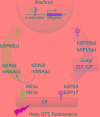The Unfolded Protein Response Supports Plant Development and Defense as well as Responses to Abiotic Stress
- PMID: 28360918
- PMCID: PMC5350557
- DOI: 10.3389/fpls.2017.00344
The Unfolded Protein Response Supports Plant Development and Defense as well as Responses to Abiotic Stress
Abstract
The unfolded protein response (UPR) is a stress response conserved in eukaryotic organisms and activated by the accumulation of misfolded proteins in the endoplasmic reticulum (ER). Adverse environmental conditions disrupt protein folding in the ER and trigger the UPR. Recently, it was found that the UPR can be elicited in the course of plant development and defense. During vegetative plant development, the UPR is involved in normal root growth and development, the effect of which can be largely attributed to the influence of the UPR on plant hormone biology. The UPR also functions in plant reproductive development by protecting male gametophyte development from heat stress. In terms of defense, the UPR has been implicated in virus and microbial defense. Viral defense represents a double edge sword in that various virus infections activate the UPR, however, in a number of cases, the UPR actually supports viral infections. The UPR also plays a role in plant immunity to bacterial infections, again through the action of plant hormones in regulating basal immunity responses.
Keywords: ER (endoplasmic reticulum) stress; IRE1; auxin; bZIP28; brassinosteroid; plant virus; protein folding; regulated-IRE1 dependent RNA decay (RIDD).
Figures


References
Publication types
LinkOut - more resources
Full Text Sources
Other Literature Sources

